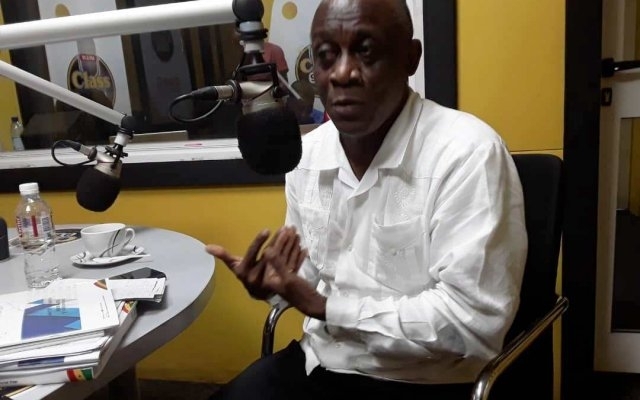Pay angry ‘crying’ depositors with ESLA fund – Terkper to gov't
 Seth Terkper
Seth Terkper
Former Finance Minister Seth Terkper says the government cannot continue to assume it is impossible to pay back depositors their locked-up capital after the collapse of some 347 microfinance companies, 39 microcredit companies, 23 savings and loans and finance house companies.
According to the former Finance Minister, there is no excuse for leaving those affected frustrated, resulting in some renewed agitations because the Nana Akufo-Addo administration can raise funds through the Energy Sector Levy Act (ESLA) fund.
Customers of failed Savings & Loans and Microfinance Institutions are bitter and have accused the government of giving them false hope after a promise last December, which was affirmed in the President’s State of the Nation Address in February that he had directed Finance Minister Ken Ofori-Atta to release GHS15.6 billion for full payment of all those affected.
These were the words of Nana Akufo-Addo on Thursday, 20 February 2020, when he delivered the SoNa to Parliament, Accra: …“I would like to repeat that all depositors of the savings and loans and microfinance institutions, including DKM which collapsed in 2015, will receive 100% of their deposits, too, once the validation exercise is concluded, and I am informed that the Receiver of the Savings and Loans and Microfinance institutions will begin, on Monday, 24th February, making payments to their customers, these monies, totalling five billion cedis, being in addition to the thirteen billion cedis being paid to the customers of the failed banks.”
Seth Terkper, who was contributing to discussions on the issue on Accra-based Citi FM last Friday, insisted that the Energy Sector Levy, established by the erstwhile Mahama administration to handle related shocks, was expected to generate GHS28 billion by 2022.
He asked: “Where did all the money go?".
He explained further: “If we are talking about the payment of GHS5 billion, GHS10 billion or even up to GHS 15 billion or even GHS20 billion, there should be enough money in the ESLA fund to have paid the depositors their full amount”.
The former Finance Minister’s comment comes in the wake of complaints about the government’s decision, through the Receiver, to cap how much depositors with very huge figures can withdraw as well as the mandatory 5-year bond at zero interest rate imposed on them for which a refusal will mean opting for a discount of the cash amount payable by the Consolidated Bank of Ghana, CBG.
It is estimated that over two million customers are affected directly or indirectly by the financial sector clean-up exercise but in March this year, the Receiver, in a statement, claimed out of more than 360,000 depositor claims, which includes 39 microcredit companies placed under official liquidation, more than 320,000 of validated claims were fully settled in cash.
The statement, however, said: “To fully settle the remaining 40,000 depositor claims in these receiverships as well as in the official liquidation of the 39 MCCs, the government provided additional funding by way of a combination of cash and bonds totalling approximately GHS5 billion to the Receiver and Official Liquidator.”
Commenting on the renewed agitations, Mr Terkper recalled that there was some restructuring in 2016 by the government of the NDC, which cost GHS2.2 billion as well as an injection of GHS250 million.
“It was negotiated directly with the banks and for all that we know, no haircuts were made to depositors’ funds,” he emphasised.
The former Finance Minister noted that the Mahama administration used funds from the Energy Sector Levy to bolster the financial sector.
“Therefore, it is erroneous to give the impression that the former administration did not do much about the financial sector situation,” he argued.
The financial sector clean-up commenced by the Akufo-Addo administration in August 2017, has led to the collapse of nine universal banks, 347 microfinance companies, 39 microcredit companies or money lenders, 15 savings and loans companies, eight finance house companies, and two non-bank financial institutions.
Last month, the official Receiver and Liquidator of the collapsed nonbank financial institutions, Mr Eric Nana Nipah, in a statement presented on his behalf by Information Minister, Kojo Oppong Nkrumah, said: "To date approximately GHS2.11 billion has been paid in cash, while about GHS2.95 billion has been paid in bonds, bringing total payments to GHS5.06 billion.”
The disclosure confirms that more than half of the promised payment has been converted to bonds at zero interest rate over a 5-year period.
Last week, a research fellow at the Institute for Fiscal Studies, Adu Owusu Sarkodie, described the development as very unfortunate. In his opinion, while the government’s resolve to pay all depositors funds is welcome, its decision to convert a sizeable chunk of the locked-up capital, especially for corporate bodies and heavy investors into bonds without their input, is worrisome.
Mr Owusu Sarkodie, who is also a Senior Lecturer at the Department of Economics, University of Ghana asked: “Why still hold on to customers’ money?”
Source: classfmonline.com
Trending News

Fuel Africa 2024: Futurize and AstraZeneca unveil groundbreaking innovations for health tech and environmental sustainability
11:57
Ejisu by-poll: 'Voting for Aduomi is handing over power to Mahama' – Bawumia
11:04
Recall parliament so gov't discharges obligations - Majority Caucus to Parliament
10:59
No one ordered Yagbonwura to get up to greet Akufo-Addo - Chieftaincy minister
11:38
UE/R: Bembisi youth spearhead construction of modern classroom block for local school
06:53
Off-duty Policemen fatally shot: Police launch manhunt for gunmen
22:29
Kasoa: Army man shot dead in land fight
11:36
Changing basic school uniforms to blue and white needless - Educationist
10:46
Appiatse reconstruction: Akufo-Addo gov’t fulfils its promise of housing delivery - Lands Minister
22:19
Kasoa land dispute: Soldier killer arrested
11:46



